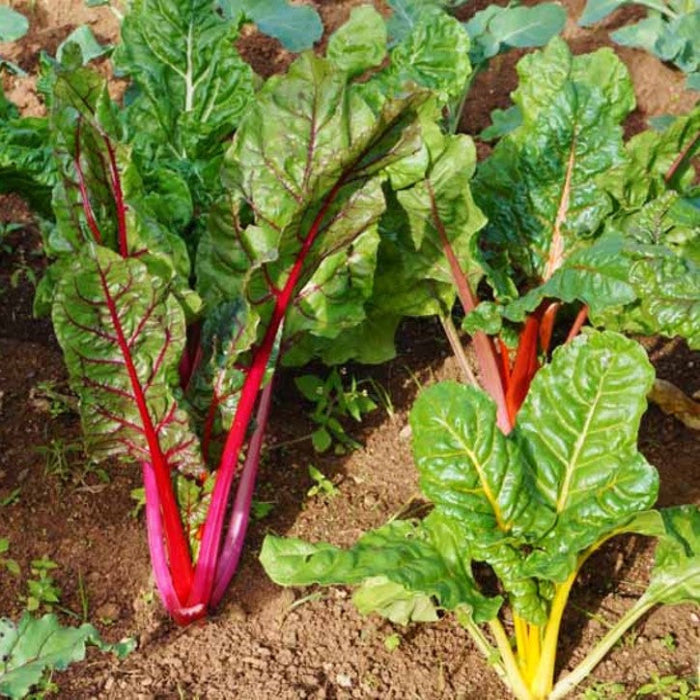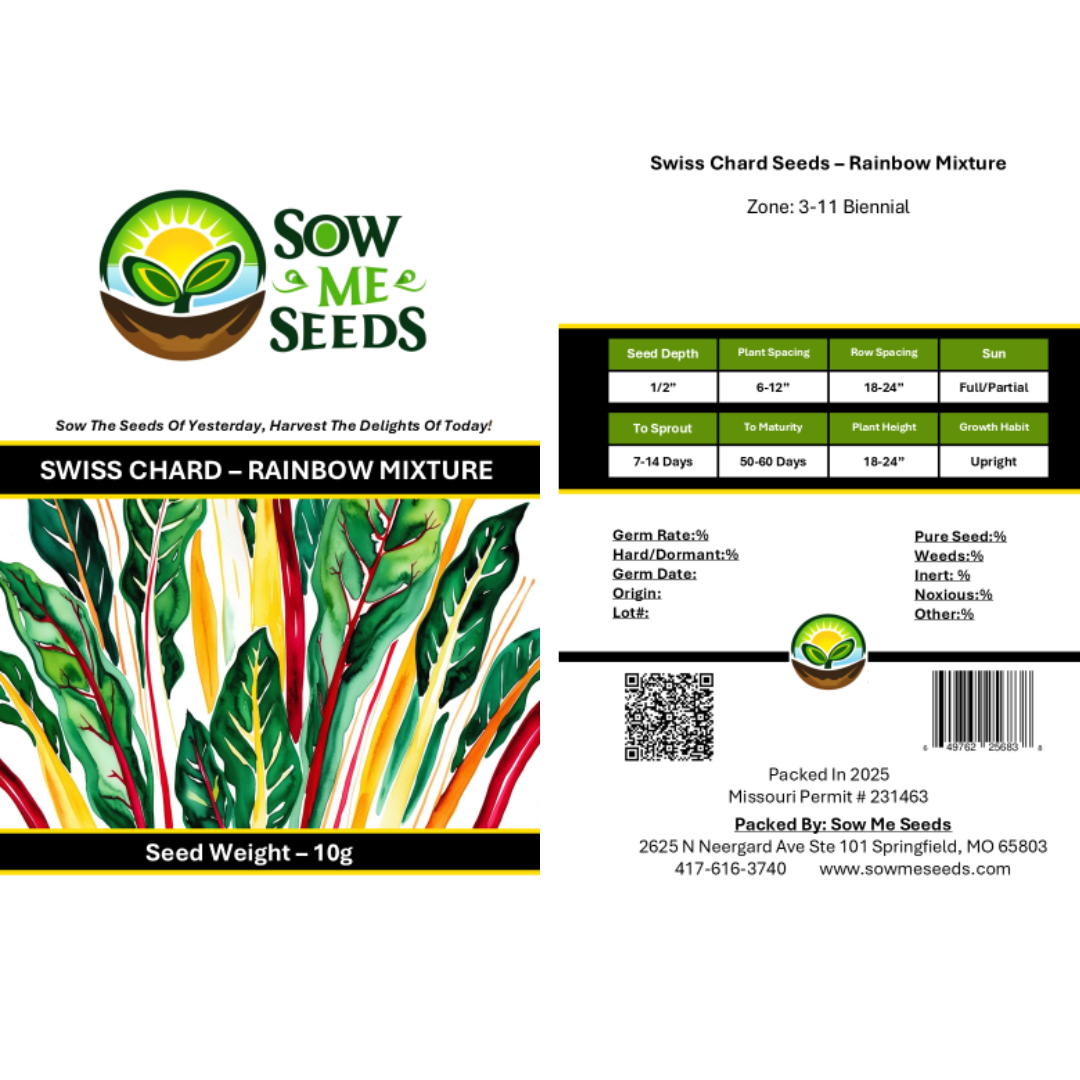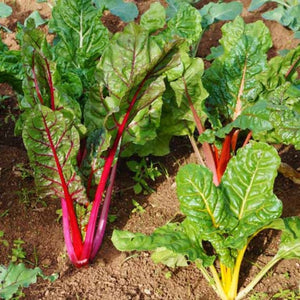- Hardiness Zone: 3-11 Annual
- Hardiness Zone: 7-11 Biennial Often Grown As An Annual
Seed Depth: 1/2 inch
Seed Spacing: 6–12 inches
Row Spacing: 18–24 inches
Sunlight: Full sun to partial shade
Days to Sprout: 7–14 days
Days to Maturity: 50–60 days
Growth Habit: Upright, leafy biennial grown as an annual
Sunlight: Thrives in full sun but tolerates partial shade, especially in warmer climates.
Soil Type: Prefers rich, well-drained soil with a pH of 6.0–7.5. Adding compost improves growth.
When to Plant: Sow seeds directly outdoors in early spring or late summer for a fall crop. For an earlier harvest, start seeds indoors 4–6 weeks before the last frost.
Direct Sowing: Plant seeds 1/2 inch deep, spacing them 6–12 inches apart in rows 18–24 inches apart. Thin seedlings to the desired spacing as they grow.
Indoor Sowing: Start seeds in trays and transplant when seedlings are 4–6 inches tall.
Succession Planting: Sow every 2–3 weeks for a continuous harvest during the growing season.
Watering: Water consistently to keep the soil evenly moist but not soggy. Mulch helps retain moisture and regulate temperature.
Fertilizing: Use a balanced fertilizer or compost at planting and mid-season to encourage leafy growth.
Pruning: Harvest outer leaves regularly to encourage new growth and maintain plant health.
Pest and Disease Control: Monitor for aphids, slugs, and leaf miners. Use organic pest control methods and ensure proper spacing for airflow.
When to Harvest: Harvest outer leaves when they are 8–10 inches long, typically 50–60 days after planting. Baby greens can be harvested earlier.
How to Harvest: Use scissors or a knife to cut leaves at the base, leaving the central growing point intact for continuous harvests.
Seed Collection: Allow plants to bolt and form seed heads. Collect seeds once heads are fully dry.
Storing Seeds: Store seeds in an airtight container in a cool, dry place.
Why You’ll Love It
Colorful Variety: Eye-catching stems in a full rainbow of colors brighten up any garden or plate.
Heat Tolerant: Performs well in warm weather where other greens may struggle.
Cut-and-Come-Again: Harvest outer leaves regularly for a steady supply of fresh greens all season long.
Highly Nutritious: Rich in vitamins A, C, and K, plus fiber and antioxidants.
Plant Characteristics
Height: 18–24 inches
Growth Habit: Upright with broad, crinkled leaves and thick, colorful stems
Leaf and Stem Color: Green to bronze leaves with multi-colored stems in red, pink, orange, yellow, and white
Days to Maturity: 50–60 days
Hardiness: Biennial grown as an annual
Flavor and Culinary Uses
Flavor: Mild and earthy with a slight sweetness — similar to spinach but with more texture
Culinary Uses: Excellent sautéed, steamed, added to soups and pasta dishes, or enjoyed raw when young
Companion Planting Tips
Good Companions: Onions, carrots, beans, and lettuce
Avoid Planting Near: Corn and potatoes (can compete for nutrients)
Bonus Benefit: Adds ornamental value to edible gardens and attracts pollinators when left to bloom
Common Issues and Solutions
Leaf Miners: Remove affected leaves early and use row covers to prevent infestation
Tough Older Leaves: Harvest younger leaves regularly for the best flavor and texture
Overcrowding: Thin seedlings to encourage airflow and full leaf development
Seeds Per Packet
| 3g | Approximately 120 |
| 7g | Approximately 280 |
Why You’ll Love It
Colorful Variety: Eye-catching stems in a full rainbow of colors brighten up any garden or plate.
Heat Tolerant: Performs well in warm weather where other greens may struggle.
Cut-and-Come-Again: Harvest outer leaves regularly for a steady supply of fresh greens all season long.
Highly Nutritious: Rich in vitamins A, C, and K, plus fiber and antioxidants.
Plant Characteristics
Height: 18–24 inches
Growth Habit: Upright with broad, crinkled leaves and thick, colorful stems
Leaf and Stem Color: Green to bronze leaves with multi-colored stems in red, pink, orange, yellow, and white
Days to Maturity: 50–60 days
Hardiness: Biennial grown as an annual
Flavor and Culinary Uses
Flavor: Mild and earthy with a slight sweetness — similar to spinach but with more texture
Culinary Uses: Excellent sautéed, steamed, added to soups and pasta dishes, or enjoyed raw when young
Companion Planting Tips
Good Companions: Onions, carrots, beans, and lettuce
Avoid Planting Near: Corn and potatoes (can compete for nutrients)
Bonus Benefit: Adds ornamental value to edible gardens and attracts pollinators when left to bloom
Common Issues and Solutions
Leaf Miners: Remove affected leaves early and use row covers to prevent infestation
Tough Older Leaves: Harvest younger leaves regularly for the best flavor and texture
Overcrowding: Thin seedlings to encourage airflow and full leaf development
Seeds Per Packet
| 3g | Approximately 120 |
| 7g | Approximately 280 |




Share and get 15% off!
Simply share this product on one of the following social networks and you will unlock 15% off!